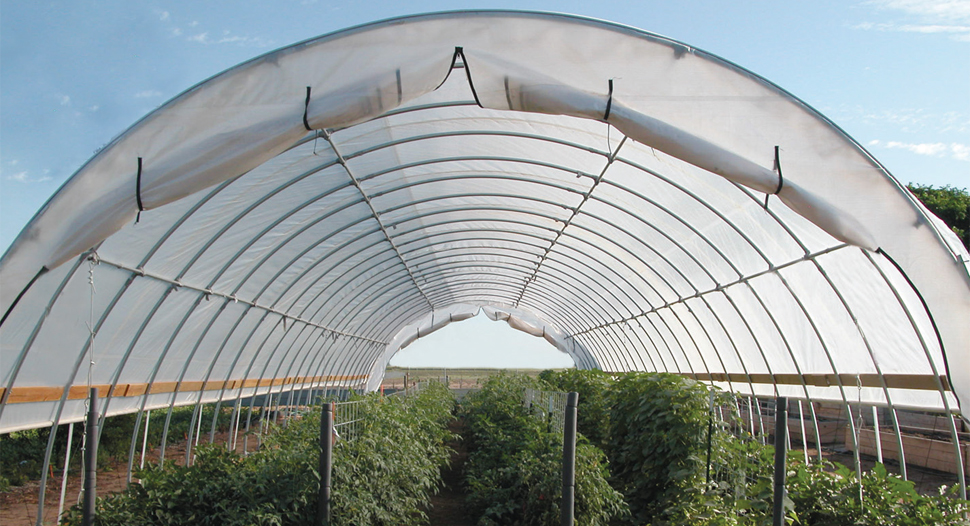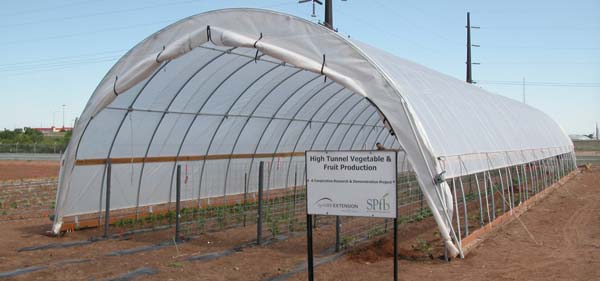Texas AgriLife Research & Extension
Challenge – Environmental factors limiting crop production
Solution – Six GrowSpan Round Premium High Tunnels
Size: One 26′ wide x 12′ high x 96′ long, Five 30′ wide x 12′ high x 96′ long
Application – Research on high tunnel production and the effect of biodegradable mulch on production
Location – Lubbock, TX
Texas AgriLife Research & Extension, part of the Texas A&M University System, performs research and provides education on agriculture, natural resources and life sciences. They are currently conducting research cooperatively with Washington State University, Western Washington University, University of Tennessee, and Texas Tech University on produce grown on biodegradable mulches both under and outside of high tunnels (USDA CSREES Award 2009-51181-05897). At two of the research sites in the Texas High Plains, including the South Plains Food Bank Farm in Lubbock, the focus is also on how high tunnels can extend the growing season in this area.
Associate Professor and Extension Vegetable Specialist for the program, Dr. Russell Wallace, has responsibilities for the Texas High Plains area. He explains, “My current vegetable research program involves evaluating weed management strategies, variety testing on tomatoes, pumpkins, watermelons and snap peas, and crop production under high tunnels.”
With the onset of this project, the program purchased one GrowSpan Round Premium High Tunnel with 5.2 oz. greenhouse fabric. Wallace says, “After reviewing our options with other companies, we decided that the Growers Supply high tunnel with 4′ rafter spacing would be best for our location. We have not been disappointed.” Wallace finds that the high tunnel can easily withstand the windy conditions of the area. He continues, “The high tunnel provided excellent preliminary results for our research project, resulting in the purchase of five additional tunnels.”
Research will be conducted over three years, according to Wallace. He says, “The six high tunnels are to be evaluated for their influence on season extension for crop production, as well as for protection against high winds and dust storms, hail, and intermittent heavy rainfalls that occur in the area.” He notes that these factors play major roles in limiting vegetable production on the Texas High Plains.
The results from crop production in the first Growers Supply high tunnel are promising. “We evaluated five pepper and four tomato varieties grown inside and outside the high tunnel,” Wallace says. “Results indicated that for both crops, yields harvested from the high tunnels were earlier, more substantial, and of higher quality than those produced outside the tunnels.” Wallace continues, “Pepper yields averaged 50% higher inside the tunnel compared to the open field, while high tunnel tomatoes averaged 25% higher than those staked, mulched or grown in wrapped cages.”
Roy Riddle, Horticultural Manager for South Plains Food Bank, provides land, irrigation, land preparation and assistance with this research. Riddle says, “The quality and quantity of tomatoes, peppers, cucumbers and eggplant grown in the existing tunnel look very favorable. I’m looking forward to increasing the production and beginning much earlier in the growing season.” The food grown for the research project is given to the food bank, where demands have increased by 25% in the past year alone. Riddle continues, “As a grower for a food bank, the ability to provide fresh, locally grown produce 10 to 12 months out of the year is very promising.”
Wallace concludes, “We are happy with the results, and look forward to more evaluations in the next three years in all six of our Growers Supply high tunnels.”
For more information about the Texas High Plains Vegetable Program, visit http://lubbock.tamu.edu/.



